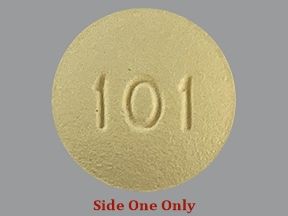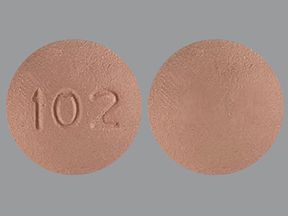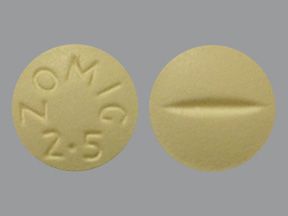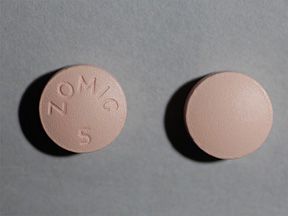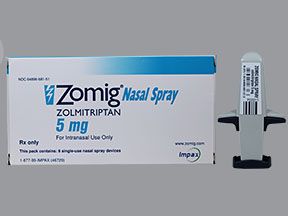Zomig (zolmitriptan) is a prescription drug that’s used to treat migraine episodes. Zomig comes as a nasal spray, a tablet you swallow, and an orally disintegrating tablet.
Zomig is used for treating migraine episodes in adults and certain children. To learn more about Zomig’s uses, see the “What is Zomig used for?” section below.
Zomig basics
Zomig contains the active ingredient zolmitriptan. (An active ingredient is what makes a drug work.) It belongs to a group of migraine medications called triptans.
Zomig is a brand-name medication that’s also available as the generic drug zolmitriptan. Note that the orally disintegrating tablets* are sold under the name Zomig-ZMT.
* An orally disintegrating tablet is one that dissolves on or under your tongue.
Like most drugs, Zomig may cause mild or serious side effects. The lists below describe some of the more common side effects that Zomig may cause. These lists don’t include all possible side effects.
Keep in mind that side effects of a drug can depend on:
- your age
- other health conditions you have
- other medications you take
Your doctor or pharmacist can tell you more about the potential side effects of Zomig. They can also suggest ways to help reduce side effects.
For more information about the side effects of Zomig, see this article.
Mild side effects
Here’s a short list of some of the mild side effects that Zomig can cause. To learn about its other mild side effects, talk with your doctor or pharmacist. Or see the Zomig prescribing information for the nasal spray and the tablets and orally disintegrating tablets.*
Mild side effects of Zomig that have been reported include:
- dizziness
- “pins and needles” feeling
- weakness
- sleepiness
- feeling warm or cold
- nausea
- heavy feeling
- dry mouth
Zomig nasal spray has other mild side effects that you may not have with the tablets or orally disintegrating tablets. These include:
Mild side effects of many drugs may go away within a few days to a couple of weeks. But if they become bothersome, talk with your doctor or pharmacist.
* An orally disintegrating tablet is one that dissolves on or under your tongue.
Serious side effects
Serious side effects from Zomig can occur, but they aren’t common. If you have serious side effects from Zomig, call your doctor right away. But if you think you’re having a medical emergency, you should call 911 or your local emergency number.
Serious side effects of Zomig that have been reported include:
- medication overuse headache, also known as rebound headaches
- neck, throat, or jaw pain
- heart attack
- irregular heart rate or rhythm
- stroke
- serotonin syndrome, which is caused by having too much serotonin in the body
- high blood pressure
- allergic reaction*
* For more information about this side effect, see “Allergic reaction” just below.
Allergic reactionSome people may have an allergic reaction to Zomig.
Symptoms of a mild allergic reaction can include:
A more severe allergic reaction is rare but possible. Symptoms of a severe allergic reaction can include swelling under your skin, usually in your eyelids, lips, hands, or feet. They can also include swelling of your tongue, mouth, or throat, which can cause trouble breathing.
Call your doctor right away if you have an allergic reaction to Zomig. But if you think you’re having a medical emergency, call 911 or your local emergency number.
Zomig is a migraine medication used to treat migraine episodes with or without aura as they happen. For this purpose, adults can take Zomig tablets and orally disintegrating tablets. Zomig nasal spray can be used by adults and children ages 12 years and older.
About migraine
Migraine is a condition that can cause severe recurring headaches and other symptoms, such as nausea or vomiting. These headaches result in a pulsing pain on one side of the head. A migraine episode lasts between 4 and 72 hours.
If you have a migraine with aura, you’ll see flashes of light or blind spots in your vision. Aura can also sometimes cause a tingling feeling in your hands or face.
About Zomig’s limitations of use
Zomig may not be used in certain situations. This is called limitations of use.
Your doctor will only prescribe Zomig if you’ve received a diagnosis of migraine. If Zomig doesn’t work for you after your first treatment, they may recommend that you stop taking it.
Zomig is only used to treat migraine episodes as they happen. It doesn’t prevent migraine episodes from occurring in the first place. And studies haven’t confirmed whether this drug is safe and effective for cluster headaches.
In addition, it’s not recommended that people with moderate to severe liver failure use Zomig nasal spray.
For more information about Zomig’s uses, talk with your doctor or pharmacist.
Find answers to some commonly asked questions about Zomig.
How does Zomig compare with the alternative drugs Imitrex and Maxalt?
Zomig, Maxalt, and Imitrex are all part of the same group of migraine drugs called triptans. They have different active ingredients, as listed below. An active ingredient is what makes a medication work.
- Zomig: zolmitriptan
- Imitrex: sumatriptan
- Maxalt: rizatriptan
Compared with other triptans, Maxalt works the fastest. It’s best for migraine episodes that usually are severe at the start but don’t last very long.
Zomig, Maxalt, and Imitrex all come in tablet form, which you can take by mouth. But if you can’t swallow pills or have severe nausea or vomiting during a migraine episode, other forms of these drugs are available.
To find out which triptan is the best migraine medication for you, talk with your doctor.
Can Zomig cause side effects from long-term use?
It’s unclear whether Zomig causes side effects from long-term use because this hasn’t been studied. Experts have not determined whether using Zomig more than three times in 30 days is safe. If you have migraine episodes more frequently than this, talk with your doctor. They can help you find a treatment that is safe and effective for you.
Taking too much pain medication for headaches, such as triptans, can cause medication overuse headaches (also known as rebound headaches). This is a severe kind of headache that is difficult to treat. But compared with certain over-the-counter pain relievers, triptans have a lower risk of causing a medication overuse headache.
To prevent medication overuse headaches, follow your doctor’s instructions on how to take Zomig. And try to avoid taking other pain medication, including over-the-counter drugs, during treatment.
If you have questions about Zomig and long-term side effects, talk with your doctor or pharmacist.
Are side effects of Zomig nasal spray different from those of Zomig and Zomig-ZMT tablets?
Yes, Zomig nasal spray has a few side effects that differ from those of Zomig tablets and Zomig-ZMT orally disintegrating tablets.* Examples include unusual taste and increased sensitivity of one or more of the senses.
In addition, studies reported fewer side effects from Zomig nasal spray than those reported from the two tablet forms. Studies also found that the nasal spray’s side effects were lower than those of both kinds of tablets.
For more information about how side effects of Zomig nasal spray differ from those of the drug’s other forms, talk with your doctor or pharmacist.
* An orally disintegrating tablet is one that dissolves on or under your tongue.
Is Zomig a controlled substance?
No, Zomig isn’t a controlled substance. A controlled substance is a drug or chemical regulated by the United States government because of its potential for misuse. (Misuse refers to taking a drug in a way other than how a doctor prescribed it.)
Some people use narcotics to treat migraine pain. A narcotic is a controlled substance because of its potential for misuse. While Zomig is a drug used to treat migraine pain, it is not a narcotic.
Can I take Tylenol with Zomig?
It’s possible that you may be able to take acetaminophen (Tylenol) with Zomig.
Zomig does not interact with Tylenol. But if you take these drugs together, Tylenol may work slower than usual. Ask your doctor whether you can take Tylenol with Zomig. They’ll tell you how much Tylenol you can safely take with Zomig to treat your migraine episodes.
Note that if you need to take Tylenol with Zomig to treat a migraine episode, Zomig may not be the right medication for you. Ask your doctor what other migraine medication may be a better treatment option in your case.
Your doctor will recommend the dosage of Zomig that’s right for you. Below are commonly used dosages, but always take the dosage your doctor prescribes.
For more information about Zomig’s dosage, see this article.
Forms and strengths
Zomig comes as a nasal spray. It also comes as two types of tablets: a tablet that you swallow and an orally disintegrating tablet (one that you dissolve in your mouth). The latter is sold under the name Zomig-ZMT.
The tablets, orally disintegrating tablets, and nasal spray are available in strengths of 2.5 milligrams (mg) and 5 mg.
Recommended dosages
You’ll take Zomig at the first signs of a migraine episode. If you have migraine episodes with aura, you may have a better result if you take Zomig when migraine pain starts.
If your migraine doesn’t get better 2 hours after taking Zomig, you can take another dose. Your doctor will tell you how much Zomig you can take in 24 hours.
Questions about Zomig’s dosage
Below are some common questions about Zomig’s dosage.
- Will I need to use Zomig long term? It’s uncertain whether taking Zomig long term is safe. Ask your doctor how long you’ll need to take Zomig.
- How long does Zomig take to work? Zomig works quickly to treat migraine symptoms, such as headaches. If Zomig works to treat your symptoms, you’ll feel better within 2 hours. If Zomig hasn’t eased symptoms within 2 hours, you can take another dose. Your doctor will tell you the maximum number of Zomig doses you can safely take in 24 hours.
Before you start taking Zomig, talk with your doctor about your treatment plan. Be sure to discuss:
- your overall health and medical history
- any other medical conditions you have
- any other medications you take
These considerations and others are described below.
Interactions
Taking a medication with certain vaccines, foods, and other things can affect how the medication works. These effects are called interactions.
Before taking Zomig, be sure to tell your doctor about all medications you take, including prescription and over-the-counter types. Also, describe any vitamins, herbs, or supplements you use. Your doctor or pharmacist can tell you about any interactions these items may cause with Zomig.
Interactions with drugs or supplements
Zomig can interact with several types of drugs. These drugs include:
- the migraine medication dihydroergotamine (Trudhesa)
- monoamine oxidase inhibitors (MAOIs), such as phenelzine (Nardil) and isocarboxazid (Marplan)
- selective serotonin reuptake inhibitors (SSRIs), such as citalopram (Celexa)
- serotonin-norepinephrine reuptake inhibitors (SNRIs), such as venlafaxine (Effexor XR)
- the Parkinson’s drug selegiline (Zelapar)
- other triptan drugs, such as rizatriptan (Maxalt), sumatriptan (Imitrex), and frovatriptan (Frova)
- the antacid cimetidine (Tagamet HB)
This list does not contain all types of drugs that may interact with Zomig. Your doctor or pharmacist can tell you more about these interactions and any others that may occur with Zomig.
Warnings
Zomig may not be right for you if you have certain medical conditions or other factors that affect your health. Talk with your doctor about your health history before you take Zomig. Factors to consider include those listed below.
Heart attack. Due to the risk of heart attack with Zomig, doctors will not usually prescribe the drug to people with certain heart conditions. This includes coronary artery disease. If you have risk factors for heart disease, your doctor will check your heart health before prescribing Zomig. Examples of risk factors include high blood pressure and diabetes.
Irregular heart rate or rhythm. Zomig can affect how your heart beats. Due to this risk, doctors will not prescribe Zomig to people with certain heart conditions. Tell your doctor about any heart problems you have. They’ll discuss with you whether Zomig is a safe treatment for your migraine episodes.
Stroke. In rare cases, triptans such as Zomig can cause strokes that may be fatal. Due to this risk, if you have had a stroke, your doctor may not prescribe Zomig. They’ll discuss with you other treatment options that are safe for you to take.
Blood vessel problems. Zomig can cause blood vessel spasms. This may lead to blood clots forming and blocking blood flow to certain parts of the body. If you have a history of blood vessel spasms, taking Zomig may increase your risk of blood flow and clotting problems. If you have a blood vessel condition or history of blood vessel problems, your doctor may recommend other treatments that are safer for you to take.
Phenylketonuria. Phenylketonuria is a genetic disease that causes blood levels of a substance called phenylalanine to increase. Zomig-ZMT orally disintegrating tablets contain phenylalanine, which can worsen this condition. If you have phenylketonuria, talk with your doctor before taking Zomig. They’ll likely prescribe Zomig tablets instead.
Liver failure. In people with moderate to severe liver failure, Zomig may build up to high levels in the blood. Higher levels of Zomig in the blood may increase the risk of side effects. If you have moderate to severe liver failure, your doctor will likely not prescribe Zomig nasal spray. Talk with your doctor about other treatments for your condition that are safe to take.
High blood pressure. Zomig can cause blood pressure to increase. In people with high blood pressure, the drug can worsen this condition. If you manage your high blood pressure with medications, you should monitor your blood pressure more often while taking Zomig. If you have unmanaged high blood pressure, your doctor may not prescribe Zomig. They’ll discuss with you other treatments that are safer for easing your migraine symptoms.
Allergic reaction. If you’ve had an allergic reaction to Zomig or any of its ingredients, your doctor will likely not prescribe Zomig. Ask them what other medications are better options for you.
Zomig and alcohol
Although some medications interact with alcohol, Zomig isn’t one of them.
But alcohol may trigger migraine episodes for some people. So you may want to avoid alcohol or limit how much you consume.
Before starting Zomig, ask your doctor or pharmacist whether it’s safe for you to consume alcohol.
Pregnancy and breastfeeding
It’s unclear whether Zomig is safe during pregnancy. If you’re pregnant or planning to become pregnant, talk with your doctor before taking Zomig.
Experts suggest that untreated migraine episodes may increase the risk of pregnancy complications. If you’re pregnant and have migraine, talk with your doctor to find the safest treatment for you.
It’s unknown whether Zomig passes into breast milk and what effects it may have on children who are breastfed.
If you’re breastfeeding or considering breastfeeding, talk with your doctor to find out whether it’s safe to do so while taking Zomig. Your doctor will help you decide whether the benefits of taking Zomig outweigh the possible risks during this time.
Costs of prescription drugs can vary depending on many factors. These factors include what your insurance plan covers and which pharmacy you use.
Zomig is available as the generic drug zolmitriptan. Generics usually cost less than brand-name drugs. Talk with your doctor if you’d like to know about taking generic zolmitriptan.
If you have questions about how to pay for your prescription, talk with your doctor or pharmacist. NeedyMeds has resources that may help decrease the cost of Zomig.
You can also check out this article to learn more about saving money on prescriptions.
Your doctor will explain how you should take Zomig. They’ll also explain how much to take and how often. Be sure to follow your doctor’s instructions.
Taking Zomig
Your doctor might prescribe Zomig tablets, orally disintegrating tablets, or nasal spray. To treat migraine episodes, you’ll take Zomig when migraine pain starts.
If your doctor prescribes Zomig tablets, you can swallow one whole with water. After 2 hours, if your migraine pain returns or doesn’t lessen, you can take another dose.
You don’t need to take Zomig-ZMT orally disintegrating tablets with water. The tablet dissolves on your tongue. As the tablet dissolves, swallow the medication. Be sure to remove an orally disintegrating tablet from its packaging only when you are ready to take it.
To use Zomig nasal spray, follow these steps:
- Keeping your head upright, close one nostril with your finger.
- Place the nozzle of the nasal spray bottle in the other nostril, and tilt your head slightly back.
- While you breathe in gently, press the plunger of the nasal spray bottle.
If you have trouble giving yourself a dose of the nasal spray, ask someone to help you.
Accessible medication containers and labels
If it’s hard for you to read the label on your prescription, tell your doctor or pharmacist. Certain pharmacies may provide medication labels that:
- have large print
- use braille
- contain a code you can scan with a smartphone to change the text into audio
Your doctor or pharmacist may be able to recommend a pharmacy that offers these options if your current pharmacy doesn’t.
Also, if you’re having trouble opening your medication bottles, let your pharmacist know. They may be able to put Zomig tablets in an easy-open container. Your pharmacist may also recommend tools to help make it simpler to open the drug’s container.
Taking Zomig with other drugs
Combining nonsteroidal anti-inflammatories drugs (NSAIDs) with triptans such as Zomig may help ease migraine symptoms. Examples of NSAIDs include ibuprofen (Advil, Motrin IB) and naproxen (Aleve, Naprosyn).
Tell your doctor about any other medications you’re taking for migraine episodes, including over-the-counter drugs. If you take too much medication for migraine episodes, you’re at risk of medication overuse headaches.
Ask your doctor about medications you can take with Zomig. They’ll recommend which are safe and how much you can take.
If you need to take another drug to relieve migraine symptoms because Zomig isn’t working by itself, tell your doctor. They may recommend other treatment options.
Questions about taking Zomig
Below are some common questions about taking Zomig.
- Can Zomig tablets be chewed, crushed, or split? Zomig tablets can be chewed, crushed, or split. If you need a smaller dose of Zomig, your doctor may recommend that you split a tablet in two. Don’t split, crush, or chew Zomig-ZMT orally disintegrating tablets.
- Should I take Zomig with food? You can take Zomig with or without food. But if you have nausea or vomiting during migraine episodes, eating food may worsen these symptoms. So you may not want to take Zomig with food.
Questions for your doctorYou may have questions about Zomig and your treatment plan. It’s important to discuss all your concerns with your doctor.
Here are a few tips that might help guide your discussion:
- Before your appointment, write down questions such as:
- How will Zomig affect my body, mood, or lifestyle?
- Bring someone with you to your appointment if doing so will help you feel more comfortable.
- If you don’t understand something related to your condition or treatment, ask your doctor to explain it to you.
Remember, your doctor and other healthcare professionals are available to help you. And they want you to get the best care possible. So don’t be afraid to ask questions or offer feedback on your treatment.
Don’t take more Zomig than your doctor prescribes. Taking more than this can lead to serious side effects. If you take too much Zomig, your doctor may closely monitor you for signs and symptoms of overdose.
What to do in case you take too much Zomig
Call your doctor if you think you’ve taken too much Zomig. You can also call 800-222-1222 to reach America’s Poison Centers or use its online resource. But if you have severe symptoms, immediately call 911 or your local emergency number. Or go to the nearest emergency room.
If you have questions about taking Zomig to treat migraine episodes, talk with your doctor or pharmacist. Knowing more about Zomig will help you decide whether to include it in your migraine treatment plan.
Here are some questions you might want to ask your doctor about Zomig:
- Can Zomig prevent migraine episodes from happening in the future?
- Which natural medications can I take to replace Zomig?
- Can I drive after taking Zomig?
- If Zomig doesn’t resolve my headache, what other options do I have?
- How should I dispose of Zomig nasal spray?
Here are a couple of articles on migraine treatments that you might find helpful:
For resources to help you manage your condition, check out this site.
To learn more about Zomig, see these articles:
To get information on different conditions and tips for improving your health, subscribe to any of Healthline’s newsletters. You may also want to check out the online communities at Bezzy. It’s a place where people with certain conditions can find support and connect with others.
Q:
I vomited after taking a Zomig tablet. What should I do?
AnonymousA:
A: Vomiting is a common symptom of migraine. If you took a Zomig-ZMT orally disintegrating tablet, you likely don’t need a second dose. If you vomited after taking a Zomig tablet, you might need to take another dose. This depends on how long after taking the tablet you vomited. Before taking another dose, contact your doctor or pharmacist to see whether you should take a second dose right away.
If vomiting often occurs when you have a migraine episode, Zomig tablets may not be the best option for you. In this case, Zomig nasal spray or Zomig-ZMT orally disintegrating tablets may be a better choice.
Other triptan medications come in different forms, such as injections. These may also be better options if you vomit when you take Zomig tablets.
To find out which migraine medication is right for you, talk with your doctor.
The Healthline Pharmacist TeamAnswers represent the opinions of our medical experts. All content is strictly informational and should not be considered medical advice.Disclaimer: Healthline has made every effort to make certain that all information is factually correct, comprehensive, and up to date. However, this article should not be used as a substitute for the knowledge and expertise of a licensed healthcare professional. You should always consult your doctor or another healthcare professional before taking any medication. The drug information contained herein is subject to change and is not intended to cover all possible uses, directions, precautions, warnings, drug interactions, allergic reactions, or adverse effects. The absence of warnings or other information for a given drug does not indicate that the drug or drug combination is safe, effective, or appropriate for all patients or all specific uses.

